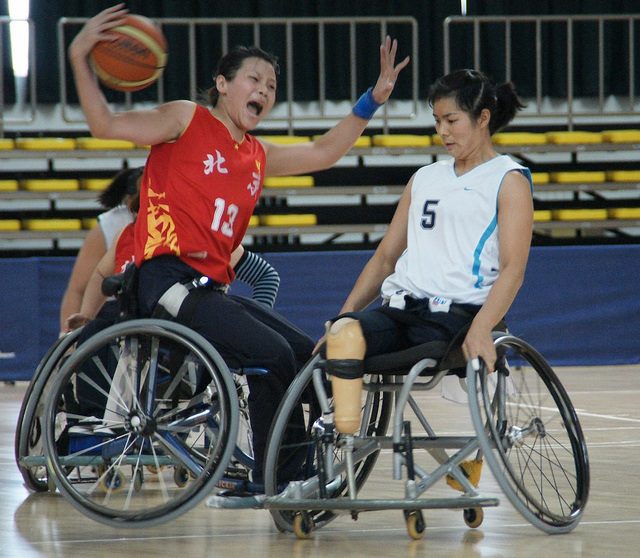The following is a guest post by Jim Smith. Be sure to check out Part 1.
Take a walk through your gym. In the free weights and racks section, we have your big guys, all trying to hit buffness. On the treadmills, are the gym bunnies, even though Girls Gone Strong makes it clear that's not the way to go. In the studio, stationary cyclists are listening to the latest dance music while trying things no responsible street cyclist would ever do. You get the picture.
There's one thing missing.
It's something people wouldn't think of putting in the gym. And it has a lot to do with that elevator stuck in the corner, which more oft than not, is used as storage closet. That missing piece is the "disabled" trainer.
Having a lifetime experience of disability, it's not a word I like. I prefer using "extremely adaptable" trainer. The reason? Because a lot of the things we couldn't do as easily, we find ways to adapt, and own it. And that's why we excel.
I see this look of "why would a disabled person need a gym?". Worst of all, I've heard that question asked out loud. As of March 2012, the population in the United Kingdom is 62.3 million and the rate of disability is 10 million people. That my friends, is a staggering ratio of 1:6.
How many businesses would shoot themselves in the foot by ignoring 1/6th of the population? So why are gyms taking so long to get on board? I can't fully answer these questions, but I think the answer resides on both sides of this statistic.
Firstly, non-disabled people are intimidated when they first walk into the gym. As Jonathan Goodman stated in this article, "The fit have created a daunting atmosphere where the unfit don't feel welcome." It's hard enough to get your average person into the gym. All the fitness hype on TV, the airbrushed photos of fitness models and the corporatization of sport isn't helping either. How are you going to attract someone in a wheelchair or with a below-the-knee prosthetic?
The other side of the coin is the disabled population. A lot of disabled people were not born disabled. They are, as a few friends have dubbed them "The newly disabled". This can be traumatizing. It has huge impacts on lifestyles and factoring in hidden disabilities like depression, you can see why getting out of the house can be hard. It takes 6-7 years from the time of paralysis for a wheelchair user to become proficient and confident enough to face the public. It takes even longer, unless they were extremely active before it, to become fit enough to want to hit a gym.
So "Why would a disabled person need a gym?".
Well firstly, the exact same reason as every other person who comes to the gym. They want to be fit. Depression can lead to obesity, and in addition to not being able to walk, there are health risks lurking under the surface.
Secondly, musculoskeletal strength. Disabled people, for numerous reasons, may not be able to do as much weight bearing exercise and without calcium or other agents, will lose bone density a bit faster.
Having a disabled personal trainer in the gym allows numerous benefits:
1: Shows that the company cares about that 1/6th of the population. Sadly, that is how it generally appears.
2: Shows empathy with client's conditions. Not to say that trainers don't. Everyone can show an understanding if they've been educated. But unless you have had spinal surgery due to kyphosis, or have a below leg amputation, you don't actually know how it feels to live with that condition. And that is what we can do.
3: We can ADAPT, and are great at finding solutions for things that you've not encountered frequently. Finding a way for your kyphotic client to deadlift safely will boost not only their confidence, but increase muscle strength in the most needed areas, the glutes and lower back.
And finally;
4: The sharing of knowledge. We all have different disabilities. How does this benefit the regular trainer? Firstly, it provides a more intimate knowledge of how we cope. It also offers a new insight that able bodied people would have a hard time coming to. We have a great understanding of the interconnectedness of our bodies. We understand intimately how certain joints respond to different stimuli and how that will benefit our daily function.
And best yet, some of us (me included), get to offer you educated test subjects for a new thought experiment or exercise. Use it! Not only do you get to learn that your scap press gives us that nice tingling sensation we all love, but it does it safely whereas some other scapula exercises can actually cause it to slip out of alignment.
Next time you're walking into your gym, and see a gym instructor with kyphosis teaching deadlifts, or trainer in a chair teaching a client long distance cycling technique, get to know them. You'll be surprised that the guy in the chair used to be a competitive cyclist, or the guy with kyphosis has done sports since he was four.
And even more surprisingly, you'll find that we're just waiting for you to join us.











